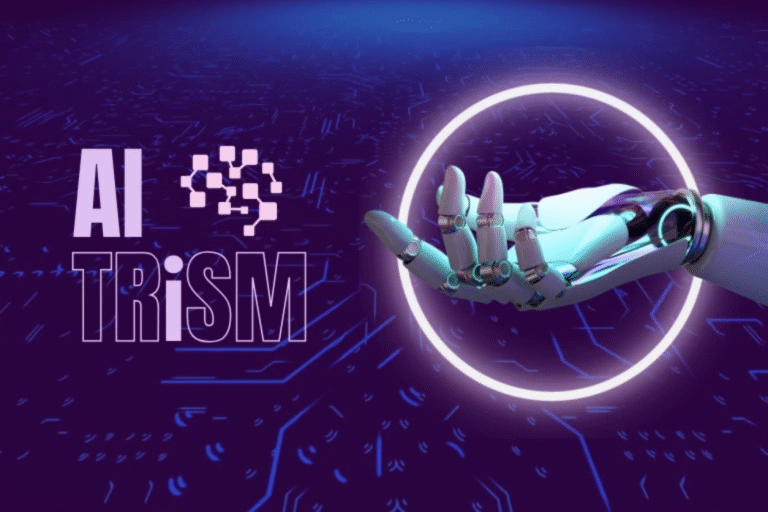In today’s fast-evolving digital landscape, Artificial Intelligence (AI) is transforming industries, from healthcare to finance, and even the Metaverse. However, with great power comes great responsibility. As AI systems become more integrated into our daily lives, concerns about trust, security, and ethical risks are growing. Enter AI TRiSM, Artificial Intelligence Trust, Risk, and Security Management—a groundbreaking framework designed to ensure AI is safe, reliable, and trustworthy. In this article, we’ll dive into what AI TRiSM is, why it’s critical for businesses and society, and how it’s shaping the future of AI. Let’s explore how AI TRiSM is setting a new standard for trust in artificial intelligence.
What is AI TRiSM?
AI TRiSM, coined by Gartner, stands for Artificial Intelligence Trust, Risk, and Security Management. It’s a comprehensive framework that addresses the challenges of deploying AI systems responsibly. Unlike traditional AI governance models, AI TRiSM integrates trust, risk, and security into a unified approach, ensuring AI models are transparent, fair, and secure. According to Gartner, AI TRiSM supports governance, trustworthiness, fairness, reliability, robustness, efficacy, and data protection, key pillars for building confidence in AI technologies.
The framework focuses on mitigating risks such as bias, data privacy violations, and cyberattacks while fostering innovation. By implementing AI TRiSM, organizations can create AI systems that not only comply with regulations but also earn the trust of users and stakeholders. As AI adoption surges—projected to contribute $15.7 trillion to the global economy by 2030—AI TRiSM is becoming a must-have for businesses aiming to stay ahead.
Why AI TRiSM Matters in 2025
As AI technologies like generative AI and large language models (LLMs) gain traction, the stakes are higher than ever. A single misstep, such as a biased algorithm or a data breach, can lead to reputational damage, legal penalties, and financial losses. Here’s why AI TRiSM is critical in today’s AI-driven world:
1. Building Trust in AI Systems
Trust is the cornerstone of AI adoption. Users seek confidence that AI systems operate with transparency, can be clearly understood, and follow ethical standards. AI TRiSM ensures that AI decisions are interpretable, reducing the “black box” problem where outcomes are unclear. For example, in healthcare, AI TRiSM can validate AI models used for diagnostics, ensuring they’re free from bias and deliver accurate results, thus fostering patient trust.
2. Mitigating Risks and Cyberthreats
AI systems are vulnerable to adversarial attacks, where malicious actors manipulate algorithms to produce harmful outcomes. By 2024, 65% of financial institutions worldwide experienced ransomware incidents, with many breaches linked to vulnerable AI systems. AI TRiSM provides robust security measures, such as automated risk checks and model monitoring, to protect against such threats.
3. Ensuring Regulatory Compliance
With frameworks like GDPR and new AI-focused legislation on the rise, adherence to compliance standards is essential. AI TRiSM helps organizations align with legal standards by implementing data governance and bias mitigation strategies. For instance, in Denmark, the Danish Business Association used AI TRiSM to perform fairness tests on financial AI models, ensuring compliance and boosting customer confidence.
4. Promoting Fairness and Ethical AI
Bias in AI can perpetuate societal inequalities. AI TRiSM addresses this by embedding fairness into the AI development lifecycle. By auditing datasets and monitoring outcomes, the framework ensures AI systems are equitable, making it a vital tool for industries like finance and hiring, where unbiased decisions are paramount.
5. Enhancing Business Value
Organizations adopting AI TRiSM can unlock significant benefits, including improved customer experiences, increased efficiency, and innovation. By analyzing customer data securely, businesses can uncover trends and personalize offerings, driving growth while maintaining trust.
Also Read Article : AI’s Next Leap: How Artificial General Intelligence is Transforming Our World
Key Components of AI TRiSM
AI TRiSM is built on four core pillars that work together to create trustworthy AI systems:
- Model Monitoring and Explainability: AI TRiSM promotes transparency by ensuring that AI models deliver clear, understandable justifications for their outputs.
- Fairness and Bias Mitigation: The framework includes tools to detect and eliminate bias in datasets and algorithms, promoting equitable outcomes.
- Robustness and Security: AI TRiSM safeguards models against cyberattacks and ensures they perform reliably under varying conditions.
- Data Protection and Privacy: By adhering to data governance principles, AI TRiSM protects sensitive information, complying with privacy laws like GDPR.
These components make AI TRiSM a holistic solution for managing the complexities of AI deployment.
Applications of AI TRiSM Across Industries
AI TRiSM’s versatility makes it applicable across diverse sectors. Here’s how it’s transforming key industries:
1. Healthcare
In healthcare, AI TRiSM helps ensure that diagnostic tools remain precise, fair, and protected against security risks. By monitoring AI models for bias, hospitals can trust AI-driven insights, improving patient outcomes and compliance with regulations like HIPAA.
2. Finance
Financial institutions leverage AI TRiSM to strengthen fraud detection mechanisms and defend against adversarial threats. Fairness tests ensure loan approvals are unbiased, increasing customer trust and regulatory compliance.
3. Metaverse and Virtual Worlds
As the Metaverse grows, AI TRiSM ensures virtual environments are safe and ethical. By securing AI-driven avatars and interactions, the framework fosters trust in immersive digital spaces.
4. Smart Cities
AI TRiSM supports smart city initiatives by securing AI systems used for traffic management and public safety. Transparent algorithms ensure equitable resource allocation, building public trust.
Challenges in Implementing AI TRiSM
While AI TRiSM offers immense potential, organizations face challenges in its adoption:
- Skill Gaps: Implementing AI TRiSM requires expertise in AI governance and security, which is in short supply.
- Evolving Threats: The dynamic nature of cyberattacks demands constant updates to AI TRiSM frameworks.
- Regulatory Complexity: Navigating global regulations can be daunting, requiring robust compliance systems.
- Cost: Small businesses may find the initial investment in AI TRiSM tools and training prohibitive.
Despite these hurdles, the long-term benefits of AI TRiSM far outweigh the challenges, making it a worthwhile investment.
How to Implement AI TRiSM in Your Organization
Ready to adopt AI TRiSM? Follow these practical steps to integrate the framework into your AI strategy:
- Assess Your AI Ecosystem: Conduct a thorough audit of your AI models, datasets, and processes to identify risks and gaps.
- Invest in Documentation Systems: Strong documentation is critical for auditing and transparency. Use standardized templates to track model performance and compliance.
- Implement Bias and Risk Checks: Deploy automated tools to monitor bias and security risks in real-time, preventing harm before it occurs.
- Train Your Team: Upskill employees in AI governance and ethics to bridge skill gaps and ensure effective implementation.
- Partner with Experts: Collaborate with AI development agencies or consultants to streamline AI TRiSM adoption.
By following these steps, organizations can build a robust AI TRiSM framework that drives trust and innovation.
The Future of AI TRiSM
As AI technology progresses, AI TRiSM will be instrumental in guiding its future direction. Here’s what lies ahead in the coming years:
- Growing Adoption: According to Gartner, by 2026, 60% of organizations leveraging AI will implement AI TRiSM frameworks to manage risks and enhance trust.
- Advanced Tools: New AI TRiSM tools will emerge, offering enhanced capabilities for real-time monitoring and bias detection.
- Global Collaboration: Governments, businesses, and academia will collaborate to standardize AI TRiSM practices, promoting ethical AI worldwide.
- Focus on Explainability: As users demand greater transparency, AI TRiSM will prioritize explainable AI, making complex models accessible to non-technical audiences.
Why AI TRiSM is the Gold Standard for Trust in AI
AI TRiSM is more than a framework, it’s a paradigm shift in how we approach AI development and deployment. By focusing on trust, risk mitigation, and security, AI TRiSM helps ensure that AI systems remain both effective and ethically dependable. As businesses and society increasingly rely on AI, adopting AI TRiSM is no longer optional—it’s essential for staying competitive and building consumer confidence.
In a world where 75% of companies without AI governance risk critical failures by 2025, AI TRiSM offers a lifeline. It empowers organizations to harness AI’s potential while safeguarding against its pitfalls. Whether you’re a healthcare provider, a financial institution, or a tech innovator, AI TRiSM is your roadmap to a trustworthy AI future.
Conclusion
AI TRiSM is revolutionizing the AI landscape by setting a new standard for trust, security, and ethical innovation. By addressing the challenges of bias, cyberattacks, and regulatory compliance, it paves the way for responsible AI adoption across industries. As we move toward an AI-driven future, embracing AI TRiSM will be the key to unlocking AI’s full potential while maintaining public trust.
Ready to implement AI TRiSM in your organization? Start by auditing your AI systems, investing in training, and partnering with experts to build a secure and trustworthy AI ecosystem. The future of AI is here, and AI TRiSM is leading the way.





